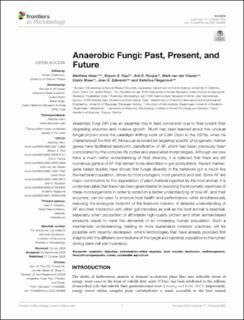| dc.contributor.author | Hess, Matthias | |
| dc.contributor.author | Paul, Shyam S. | |
| dc.contributor.author | Puniya, Anil K. | |
| dc.contributor.author | van der Giezen, Mark | |
| dc.contributor.author | Shaw, Claire | |
| dc.contributor.author | Edwards, Joan E. | |
| dc.contributor.author | Fliegerova, Katerina | |
| dc.date.accessioned | 2021-04-23T12:20:59Z | |
| dc.date.available | 2021-04-23T12:20:59Z | |
| dc.date.created | 2020-12-17T15:33:45Z | |
| dc.date.issued | 2020-10 | |
| dc.identifier.citation | Hess, M., Paul, S.S., Puniya, A.K. et al. (2020) Anaerobic Fungi: Past, Present, and Future. Frontiers in Microbiology, 11:584893. | en_US |
| dc.identifier.issn | 1664-302X | |
| dc.identifier.uri | https://hdl.handle.net/11250/2739366 | |
| dc.description.abstract | Anaerobic fungi (AF) play an essential role in feed conversion due to their potent fiber degrading enzymes and invasive growth. Much has been learned about this unusual fungal phylum since the paradigm shifting work of Colin Orpin in the 1970s, when he characterized the first AF. Molecular approaches targeting specific phylogenetic marker genes have facilitated taxonomic classification of AF, which had been previously been complicated by the complex life cycles and associated morphologies. Although we now have a much better understanding of their diversity, it is believed that there are still numerous genera of AF that remain to be described in gut ecosystems. Recent marker-gene based studies have shown that fungal diversity in the herbivore gut is much like the bacterial population, driven by host phylogeny, host genetics and diet. Since AF are major contributors to the degradation of plant material ingested by the host animal, it is understandable that there has been great interest in exploring the enzymatic repertoire of these microorganisms in order to establish a better understanding of how AF, and their enzymes, can be used to improve host health and performance, while simultaneously reducing the ecological footprint of the livestock industry. A detailed understanding of AF and their interaction with other gut microbes as well as the host animal is essential, especially when production of affordable high-quality protein and other animal-based products needs to meet the demands of an increasing human population. Such a mechanistic understanding, leading to more sustainable livestock practices, will be possible with recently developed -omics technologies that have already provided first insights into the different contributions of the fungal and bacterial population in the rumen during plant cell wall hydrolysis. | en_US |
| dc.language.iso | eng | en_US |
| dc.publisher | Frontiers Media S.A | en_US |
| dc.rights | Navngivelse 4.0 Internasjonal | * |
| dc.rights.uri | http://creativecommons.org/licenses/by/4.0/deed.no | * |
| dc.title | Anaerobic Fungi: Past, Present, and Future | en_US |
| dc.type | Peer reviewed | en_US |
| dc.type | Journal article | en_US |
| dc.description.version | publishedVersion | en_US |
| dc.rights.holder | Copyright © 2020 Hess, Paul, Puniya, van der Giezen, Shaw, Edwards and Fliegerová. | en_US |
| dc.subject.nsi | VDP::Matematikk og Naturvitenskap: 400::Basale biofag: 470 | en_US |
| dc.source.pagenumber | 18 | en_US |
| dc.source.volume | 11 | en_US |
| dc.source.journal | Frontiers in Microbiology | en_US |
| dc.identifier.doi | 10.3389/fmicb.2020.584893 | |
| dc.identifier.cristin | 1861205 | |
| cristin.ispublished | true | |
| cristin.fulltext | original | |
| cristin.qualitycode | 2 | |

